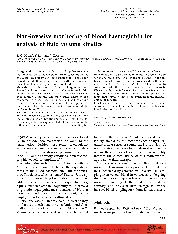摘要
Background A commercially available pulse oximeter that reports blood haemoglobin (Hb) concentration is evaluated. This study considers whether this device can provide serial Hb data that would be sufficiently reliable for volume kinetic analysis of infusion fluids. Methods Forty infusions of 5 or 10 ml/kg of acetated Ringer's solution were given over 15 min in 10 healthy volunteers. Hb was measured on 17 different occasions over 120 min using the Radical 7 pulse oximeter and compared with the result of invasive blood sampling (control). A one-volume kinetic model was applied to each data series. The pulse oximeter also reported the perfusion index (PI). Results The median deviation between the 680 invasive and non-invasive Hb samples (the accuracy) was 1.6% and the absolute median deviation (precision) was 4.6%. Between-subject factors explained half of the variation in the difference between non-invasive vs. invasive sampling. Ten of the 40 non-invasive series of Hb values were discarded from kinetic analysis due to poor quality. The remaining 30 series showed a smaller distribution volume for the infused fluid when kinetic analysis was based on the non-invasive method (3.0 vs. 5.3 l; P < 0.001). This was due to co-variance with the PI, which exaggerated the decrease in Hb caused by the infusions. The non-invasive method might provide useful kinetic data at the group level, but individual curves deviated too much from the invasive data to be reliable. Conclusions Non-invasive measurement of the Hb concentration during volume loading could not provide useful kinetic data for individuals.
- 出版日期2010-11
- 单位浙江大学
